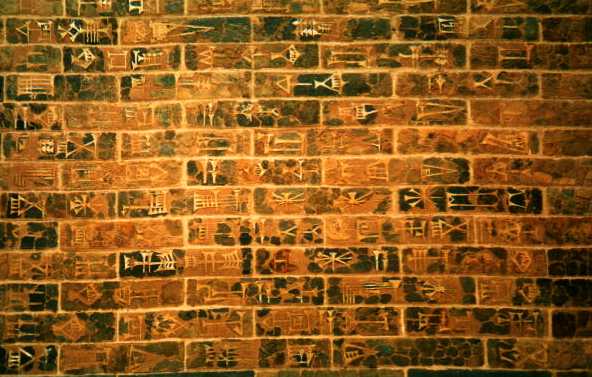





| DESCRIPTION | |
|---|---|
| Language: | Akkadian |
| Medium: | glazed brick |
| Size: | c. 15 meters high c. 10 meters wide |
| Length: | 60 lines of writing |
| Genre: | Dedication Inscription |
| Dedicator: | Nebuchadnezzar King of Babylonia (reigned 605—562 BCE) |
| Approximate Date: | 600 BCE |
| Place of Discovery: | Babylon (near modern Baghdad, Iraq) |
| Date of Excavation: | 1899—1914 |
| Current Location: | Pergamon Museen (Berlin, Germany) |

 |

| TRANSLATION (Adapted from Marzahn 1995:29-30) |
|
|

| DISCUSSION QUESTIONS |
|
1. Noting Nebuchadnezzar's powerful position and honor, why does
he consider himself "humble"? What did humility mean in an
ancient Middle Eastern context? (See Malina
1998) 2. What is the connection of mountain imagery with regard to ancient temples? (see Hanson 1994) 3. What functions might the bulls, lions, and dragons serve beyond decoration? 4. How does Nebuchadnezzar understand his relationship to the gods of Babylon? What does this have to do with the ideology of kingship in ancient Mesopotamia? 5. Compare and contrast this inscription to the one Akish had inscribed in honor of Ptgyh (or Ptnyh) in Ekron. |

| SELECT BIBLIOGRAPHY |
|
Hanson, K. C. "Transformed on the Mountain: Ritual
Analysis and the Gospel of Matthew." Semeia 67
(1994[95]):147-70. Malina, Bruce J. "Humility." In Handbook of Biblical Social Values, 118-20. Ed. J. J. Pilch and B. J. Malina. 2d ed. Peabody, Mass.: Hendrickson, 1998. Marzahn, Joachim. The Ishtar Gate, The Processional Way, The New Year Festival of Babylon. Mainz am Rhein, Germany: Philipp von Zaubern, 1995. Sack, Ronald H. "Nebuchadnezzar." In Anchor Bible Dictionary 4:1058-59. D. N. Freedman, ed. New York: Doubleday, 1992. Sack, Ronald H. "Nebuchadnezzar and Nabonidus in Folklore and History." Mesopotamia 17 (1982):67-131. Saggs, H. W. F. The Greatness That Was Babylon. 2d ed. London, 1988. Wiseman, D. J. Nebuchadnezzar and Babylon. Oxford: Oxford Univ. Press, 1985. |
 Return to K. C. Hanson's Collection of Mesopotamian Documents
Return to K. C. Hanson's Collection of Mesopotamian Documents
 Return to K. C. Hanson's Collection of Ancient Documents
Return to K. C. Hanson's Collection of Ancient Documents
 Go to K. C. Hanson's Photo Gallery of Mesopotamia
Go to K. C. Hanson's Photo Gallery of Mesopotamia
 Go to K. C. Hanson's Photo Gallery of Syria & Palestine
Go to K. C. Hanson's Photo Gallery of Syria & Palestine
 Return to K. C. Hanson's HomePage
Return to K. C. Hanson's HomePage